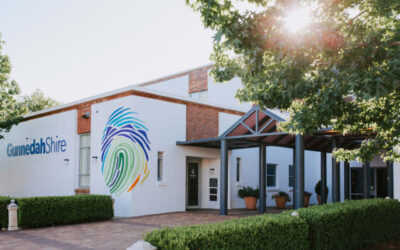April 25 was officially named Anzac Day in 1916 a year after Australian and New Zealand Army Corps soldiers formed part of the allied expedition that set out to capture the Gallipoli peninsula. These became known as Anzacs and the pride they took in that name continues to this day.
The Anzacs landed on Gallipoli and met fierce resistance from the Ottoman Turkish defenders and the campaign dragged on for eight months when the allied forces were evacuated. Both sides suffered heavy casualties and endured great hardships and more than 8000 Australian soldiers were killed.
The meaning of Anzac Day today includes the remembrance of all Australians killed in military operations and those who have served in conflicts around the world.
As the Gunnedah community and surrounding villages came to terms with the tragic loss of life in the Great War, war memorials were erected in memory of those who died.

Wreaths surround Gunnedah Cenotaph with an Australian flag in the foreground during last year’s Anzac Day service.
Twenty-six former students of Gunnedah Public School paid the ultimate sacrifice in the 1914-18 ‘war to end all wars’ and one of Gunnedah’s earliest memorials was established on the wall of the building, opened in 1900 by the local Member THH Goodwin.
The proud memorial is still visible today from the cenotaph and is now located on the wall of Carinya Christian Community School. The memorial contains 160 names of former students from the late 19th century through to the end of World War I.
Victims of war, those who died, were Rupert Bussell, Reginald Bussell, Harold Ballard, Jack Bloomfield, Harold and Leslie Benning (brothers), John Babbage, Edwin Cohen, Robert Cock, Henry Corcoran, Lloyd Corliss, David Cushan, Harold Dumbrell, Karl Hargrave, Watkin Hawke, Stanley Jarmain, Charles (Reg) Martin, Harley McDonagh, Les Neville, John Podger, George Reading, Irving Thompson, Robert Thompson, William Tripcony, Frederick Pike and Charles Johnston.
Six Gunnedah soldiers won the Military Medal during the war – Lieut. Watkins William Hawke, brothers – Gunner Howard Randolph and Corporal Leslie Oliver Douglas, Sgt James Kirkpatrick, Lieut. Louis John (Jack) Mathias, who received the Military Medal and Bar and the Distinguished Conduct Medal (DCM), and Sgt Victor Wright Thompson. Sgt Kirkpatrick also received the French Croix de Guerre.
It was a sombre occasion, the day the Mullaley Memorial Roll was unveiled on November 25, 1923. The guard of honour was formed by Gunnedah Boy Scouts, who were driven to Mullaley by prominent Gunnedah citizens George Coffin and MC (Mahlon Cowlishaw) Tweedie over what was regarded as a “horror” road.
The memorial to soldiers from the district who served in World War I was opened by Mrs AJ Rathie, of Mt Nombi, Mullaley, whose son, Archibald Anderson Rathie, was killed in action on Lone Pine, Gallipoli, in August 1915.
On the other side of the monument is John Sevil, chairman of the Mullaley memorial committee and next to him, holding the sunshade, is his wife Mary. On the left side of the photograph is Boy Scout Kevin Ormiston, third from the front, who later became a highly qualified accountant and was in business in Gunnedah for more than 60 years. The inquisitive one was then 11 years of age. Those who died were G. King, M. Balkin, JC Rathie, J. Simson, WT Watt, J. Turner, J. Soady, R. Cock, FJ Watt, F. Jenkins, WJ Best, WH McCroanan, JF Jacksonn and JW McMaster.
The Gunnedah Cenotaph, originally known as the Soldiers Memorial, was unveiled by Captain CLA Abbott on Monday, November 21, 1927, in front of a large crowd.

The Gunnedah Cenotaph illuminated during the dawn service.
The Sydney Morning Herald of November 22, 1927, reported that many wreaths were placed on the monument which had been constructed at a cost of 600 pounds obtained by direct subscriptions. The memorial had been erected in a central position between the post office and public school with 51 names inscribed on the Roll of Honour. It originally included a fence and gate that faced Conadilly Street. Every year on Anzac Day, crowds gather for the Dawn Service and later for the community march along Conadilly Street and although the number of war veterans has decreased each year, young people continue to honour those who served by marching in their honour with gratitude in their hearts. Lest we Forget!
The Cenotaph was officially unveiled by the federal Member for Gwydir, Captain Charles Lydiard Aubrey Abbott, on Monday, November 21, 1927. In his speech Captain Abbott said, in part: “I do not defend war. No person who has experienced it and knows its sufferings, can do so, but I do say this – that war, being necessary, being forced upon us, can we help thrilling with pride when we know what Australians did?”
Every year the Cenotaph is the focus of commemorative services on Anzac Day and Remembrance Day.
To order photos from this page click here



